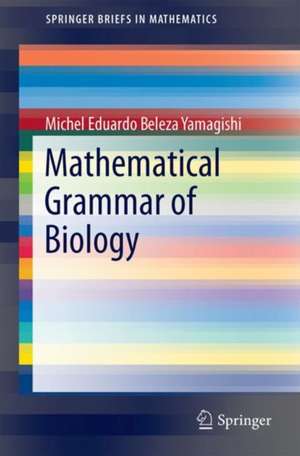Mathematical Grammar of Biology: SpringerBriefs in Mathematics
Autor Michel Eduardo Beleza Yamagishien Limba Engleză Paperback – 8 sep 2017
Din seria SpringerBriefs in Mathematics
-
 Preț: 380.25 lei
Preț: 380.25 lei -
 Preț: 380.84 lei
Preț: 380.84 lei -
 Preț: 380.29 lei
Preț: 380.29 lei -
 Preț: 383.93 lei
Preț: 383.93 lei -
 Preț: 350.11 lei
Preț: 350.11 lei -
 Preț: 352.28 lei
Preț: 352.28 lei -
 Preț: 351.57 lei
Preț: 351.57 lei -
 Preț: 378.92 lei
Preț: 378.92 lei -
 Preț: 341.60 lei
Preț: 341.60 lei - 20%
 Preț: 388.19 lei
Preț: 388.19 lei -
 Preț: 379.48 lei
Preț: 379.48 lei -
 Preț: 446.65 lei
Preț: 446.65 lei -
 Preț: 351.57 lei
Preț: 351.57 lei - 15%
 Preț: 463.68 lei
Preț: 463.68 lei -
 Preț: 377.95 lei
Preț: 377.95 lei -
 Preț: 378.12 lei
Preț: 378.12 lei -
 Preț: 352.28 lei
Preț: 352.28 lei -
 Preț: 379.68 lei
Preț: 379.68 lei -
 Preț: 376.80 lei
Preț: 376.80 lei -
 Preț: 351.90 lei
Preț: 351.90 lei -
 Preț: 380.07 lei
Preț: 380.07 lei -
 Preț: 352.28 lei
Preț: 352.28 lei -
 Preț: 350.81 lei
Preț: 350.81 lei -
 Preț: 343.72 lei
Preț: 343.72 lei -
 Preț: 349.41 lei
Preț: 349.41 lei - 15%
 Preț: 464.18 lei
Preț: 464.18 lei -
 Preț: 351.90 lei
Preț: 351.90 lei - 15%
 Preț: 464.32 lei
Preț: 464.32 lei -
 Preț: 381.00 lei
Preț: 381.00 lei -
 Preț: 344.47 lei
Preț: 344.47 lei - 15%
 Preț: 462.19 lei
Preț: 462.19 lei -
 Preț: 377.18 lei
Preț: 377.18 lei -
 Preț: 378.34 lei
Preț: 378.34 lei -
 Preț: 345.45 lei
Preț: 345.45 lei -
 Preț: 355.76 lei
Preț: 355.76 lei - 20%
 Preț: 352.85 lei
Preț: 352.85 lei -
 Preț: 453.17 lei
Preț: 453.17 lei -
 Preț: 380.45 lei
Preț: 380.45 lei -
 Preț: 377.95 lei
Preț: 377.95 lei -
 Preț: 343.00 lei
Preț: 343.00 lei -
 Preț: 562.34 lei
Preț: 562.34 lei - 15%
 Preț: 461.73 lei
Preț: 461.73 lei -
 Preț: 379.68 lei
Preț: 379.68 lei -
 Preț: 379.68 lei
Preț: 379.68 lei -
 Preț: 411.36 lei
Preț: 411.36 lei -
 Preț: 343.72 lei
Preț: 343.72 lei -
 Preț: 350.11 lei
Preț: 350.11 lei -
 Preț: 448.21 lei
Preț: 448.21 lei -
 Preț: 378.92 lei
Preț: 378.92 lei -
 Preț: 344.86 lei
Preț: 344.86 lei
Preț: 376.59 lei
Nou
Puncte Express: 565
Preț estimativ în valută:
72.08€ • 78.32$ • 60.59£
72.08€ • 78.32$ • 60.59£
Carte tipărită la comandă
Livrare economică 21 aprilie-05 mai
Preluare comenzi: 021 569.72.76
Specificații
ISBN-13: 9783319626888
ISBN-10: 3319626884
Pagini: 71
Ilustrații: XII, 82 p. 19 illus., 17 illus. in color.
Dimensiuni: 155 x 235 mm
Greutate: 0.15 kg
Ediția:1st ed. 2017
Editura: Springer International Publishing
Colecția Springer
Seria SpringerBriefs in Mathematics
Locul publicării:Cham, Switzerland
ISBN-10: 3319626884
Pagini: 71
Ilustrații: XII, 82 p. 19 illus., 17 illus. in color.
Dimensiuni: 155 x 235 mm
Greutate: 0.15 kg
Ediția:1st ed. 2017
Editura: Springer International Publishing
Colecția Springer
Seria SpringerBriefs in Mathematics
Locul publicării:Cham, Switzerland
Cuprins
Chapter 01- Introduction.- Chapter 02- Modeling Human Nucleotide Frequencies.- Chapter 03- Expanding the Grammar of Biology.- Chapter 04 - "In God We Trust; All Others, Bring Data."- References.
Recenzii
“The book presents itself as a inclusive introduction to nucleotide and k-mer frequencies in genomes across the tree of life, having as its focal point the Chargaff parity rule. … The book is written in accessible terms and presents itself as an optimal first exposure to the interdisciplinary field of mathematical biology. It can be enjoyed by a wide range of audiences, but its appeal consists in the possibility of it being read by younger readers.” (Irina Ioana Mohorianu, zbMATH 1395.92002, 2018)
“The volume is appropriate for anyone interested in computational biology and synthetic biology. It is short and easy to read, and provides a refreshing view on many aspects of DNA structure at the level of abstraction of strings over a very short alphabet. The author shows very clearly and convincingly that the question ofwhat is the actual code of life is far from answered.” (Sara Kalvala, Computing Reviews, July, 2018)
Notă biografică
Michel Eduardo Beleza Yamagishi is a senior researcher at Embrapa Informática Agropecuária, working at Embrapa Multiuser Bioinformatics Laboratory. He holds a PhD (2001) and a Master’s in Applied Mathematics from the University of Campinas (Unicamp). His fields of research include bioinformatics, genomics and optimization problems.
Textul de pe ultima copertă
This seminal, multidisciplinary book shows how mathematics can be used to study the first principles of DNA. Most importantly, it enriches the so-called “Chargaff’s grammar of biology” by providing the conceptual theoretical framework necessary to generalize Chargaff’s rules. Starting with a simple example of DNA mathematical modeling where human nucleotide frequencies are associated to the Fibonacci sequence and the Golden Ratio through an optimization problem, its breakthrough is showing that the reverse, complement and reverse-complement operators defined over oligonucleotides induce a natural set partition of DNA words of fixed-size. These equivalence classes, when organized into a matrix form, reveal hidden patterns within the DNA sequence of every living organism. Intended for undergraduate and graduate students both in mathematics and in life sciences, it is also a valuable resource for researchers interested in studying invariant genomic properties.
Caracteristici
Offers the first detailed development of the conceptual theoretical framework necessary to search for DNA’s first principles Shows how mathematical modeling can be applied to the study of DNA’s language Proves that the results are not only aesthetically beautiful, but are also confirmed by more than 96% of all genomic sequences publicly available Includes supplementary material: sn.pub/extras
